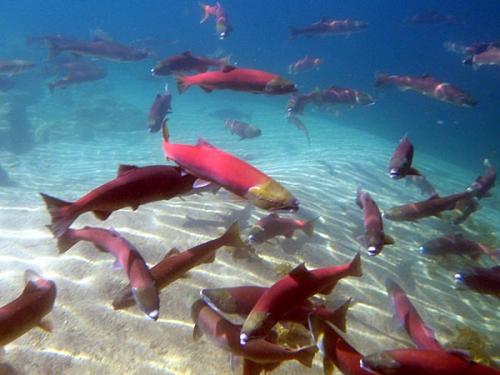forum
library
tutorial
contact

BiOp Progress Report
Says Goals Are On Track
by Bill Rudolph
NW Fishletter, November 21, 2014
|
the film forum library tutorial contact |

|
BiOp Progress Report
by Bill Rudolph
|
 Northwest Action Agencies say they're on track to meet BiOp goals in hydro performance, habitat quality improvements, predator management, and hatchery actions by 2018, but a few glitches have occurred on the way.
Northwest Action Agencies say they're on track to meet BiOp goals in hydro performance, habitat quality improvements, predator management, and hatchery actions by 2018, but a few glitches have occurred on the way.
Most salmon and steelhead populations have trended upward since 1990, but Upper Columbia spring Chinook have not, according to the latest annual progress report, released Nov. 14. The report says no "statistically significant" trend in abundance is evident. On the other hand, Upper-C steelhead are showing a positive trend.
The report also says a puzzling decline in adult survival of Snake River spring Chinook and steelhead through the hydro system will be investigated. In recent years, the stocks have shown a survival rate about 10 percent below the 90-percent performance standard (5-year rolling average).
According to the report, "the adult performance estimates are influenced by effects of dam passage as well as unreported harvest and inaccurate stray rate estimates that cannot be determined through detection of PIT tagged fish at dams. Also, high flows and high spill levels at dams can affect the estimates because they are known to increase fallback and delay of adults. Increased fallback and delay can result in increased losses due to sea lion predation below Bonneville Dam."
The U.S. Army Corps of Engineers began a two-year study in 2013 to investigate the problem, and installed PIT-tag detection systems at The Dalles, Lower Monumental and Little Goose dams to better quantify the puzzling losses in the lower Columbia. "In addition," says the report, "the parties in United States v. Oregon are also researching the higher than expected losses. As part of this research, the United States v. Oregon technical advisory committee, as well as the NOAA Fisheries' Science Center, are reviewing PIT-tag data to evaluate potential causes."
As for juvenile fish survival, passage at most dams has reached BiOp performance standards. However, the report says that 2013 survival estimates for subyearling Chinook (fall Chinook) at two dams on the lower Snake did not quite reach the 93-percent standard for each project.
At Little Goose Dam, 2013 subyearling survival averaged 90.76 percent, and 92.97 percent at Lower Monumental Dam. The 2012 subyearling survival estimates beat the standard with 97.89-percent and 95.08-percent survival, respectively.
"The Corps, in coordination with NOAA and the other Action Agencies, is reviewing the 2012/2013 testing results to assess the cause of this difference and determine the next steps to satisfy the performance standards for summer migrants at Little Goose Dam," says the report.
Overall, passage improvements at the dams have led to reduced travel time for juvenile fish through the hydropower system, says the report, and it "was shorter than the five years before the BiOp for steelhead and about the same for Chinook. Steelhead travel near the water surface, so they appear to be getting the greatest benefit from surface passage."
With many restoration projects under intense scrutiny, the issue of density dependence has appeared in some places where work has been undertaken, like in the John Day Basin, where Bridge Creek is located. As noted in BPA's 2014 update on tributary habitat improvement, "While steelhead abundance and survival increased following habitat improvements in the Bridge Creek IMW [Intensively Monitored Watershed], steelhead growth simultaneously slowed. Biologists concluded that the slowing growth resulted from density dependence, which refers to the effects of increased competition for limited resources that can take place as a population expands and approaches the carrying capacity of the habitat."
The report says that fish populations showing signs of "steep" density dependence could be targeted for restoration. If more projects show similar problems, it could mean that some estimates of fish benefits could be overly optimistic.
The Independent Scientific Advisory Board is expected to release a report on density dependence next January, and it was reported that they are taking a hard look at old estimates of returning salmon numbers in the Columbia Basin, which were in the 7 million to 14 million-fish range. With a more nuanced look at original habitat conditions, the actual returns may have been more likely one-half to one-third of those old estimates, in the 4 million to 5 million-fish range.
In 2013, the progress report notes that 1.3 million adult salmon and steelhead (hatchery and wild) were counted past Bonneville Dam, nearly twice the 10-year average. That's where the report ends, but the fish have kept on coming. In 2014, the Bonneville count was about double that, at 2.6 million.
Related Pages:
BiOp Progress Report Says Goals Are On Track by Bill Rudolph, NW Fishletter, 11/21/14
learn more on topics covered in the film
see the video
read the script
learn the songs
discussion forum
